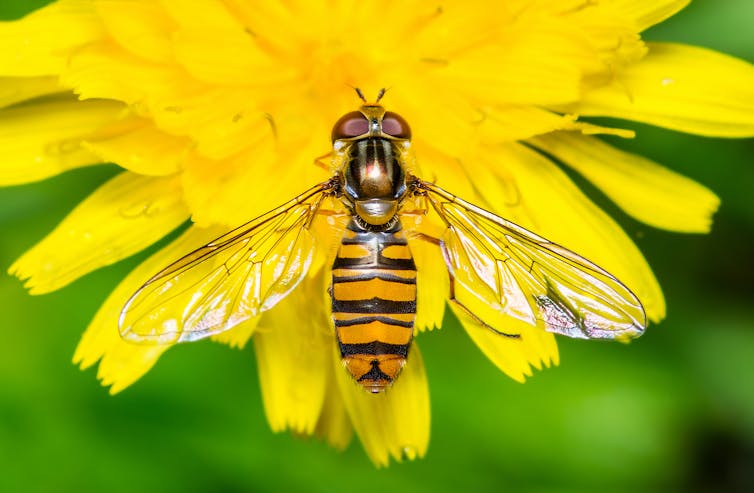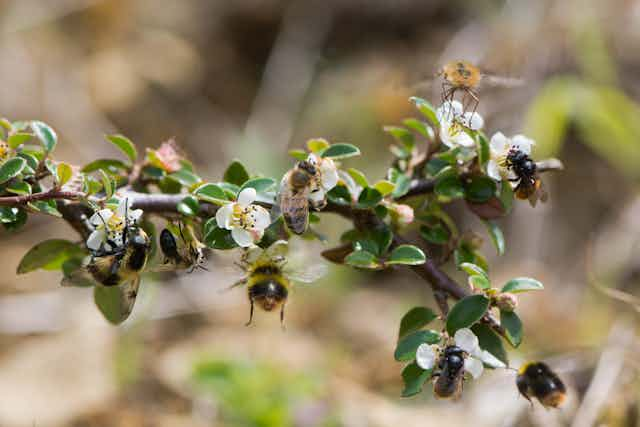Bees have had a tough time for decades. The number of bee species has seen a long-term decline across Europe and North America, and many species of wild bees have seen their total numbers decline. And although the global population of commercially managed honeybees has long been increasing as honey farming expands, the last ten years have seen individual honeybee colonies collapsing in significant numbers in the US, and to a lesser degree in other parts of the world.
Many countries have banned or restricted the use of pesticides such as neonicotinoids in farming because of their links to bee decline. But this may not be enough to stem the decline, as habitat loss, disease and parasites are also major threats to bees.
My colleagues and I have discovered evidence that suggests bee viruses are being spread much more widely than previously thought thanks to another pollinating insect, the hoverfly. Urgent research is now needed to work out to what degree hoverflies are exposing bees to disease, and if the hoverfly population is also threatened.
Bee viruses are not uncommon. For example, they can be found in about 20% to 25% of wild bumblebee foragers. From studies of honey bees, we know that bee viruses can have substantial effects on the insects’ health. Some cause symptoms such as paralysis, deformities such as crippled wings, and many result in an early death. Wild bees are also affected by these viruses. For example, deformed wing virus shortens the life of a bumblebee by an average of six days (down from around six weeks in the lab).

It is easy to see how humans have changed the environment for bees over the past few decades, using more pesticides and removing wildflowers from the landscape as farming has becoming more intense. But bee diseases are invisible to the casual observer, and it’s much less obvious how we could combat them.
Viruses are particularly important because they can evolve very quickly. This allows them to infect new species relatively easily while still affecting previously infected species. We see this every winter with new flu strains that can infect people who’ve had the disease before.
Virus spreading
Recent research has shown that bee viruses can spread between commercially managed honey bees and other wild species such as bumble bees. The most likely way this happens is that infected bees contaminate flowers with their viruses, which then infect other bees that come to feed. We already know that other bee parasites can be spread in this way.
Our new research shows that bees face another disease risk from hoverflies that feed at and pollinate the same flowers. Hoverflies are often mistaken for bees because of their black and yellow stripes, although they have no stings. The one previous study that looked at this topic found no evidence for bee viruses in hoverflies. But new data collected by Kaitlin Deutsch, formerly of Oxford University, and analysed by myself and colleagues at Royal Holloway, suggests hoverflies do indeed harbour bee viruses and that they move freely between the species.

Many hoverflies, including one of the species that we found bee viruses in (both drone flies), undertake large annual migrations across Europe. This means hoverflies could easily spread new strains of viruses that local bees haven’t adapted to, putting them at particular risk.
Given that many wild bee species are already in long-term decline, it’s important that we now try to learn how much of a threat viruses pose to them, and exactly what role the hoverfly plays in spreading bee diseases. But because hoverflies are important pollinators in their own right, with some species facing their own decline, we also need to find out how they are being affected by the viruses.
It may be possible to reduce the spread of these viruses by stopping them being so readily transferred between bees and hoverflies, perhaps by planting more flowers that attract only one or the other.
But for now, this discovery reminds us that bee decline is much more complex than the idea that pesticides are driving all pollinators to extinction.

